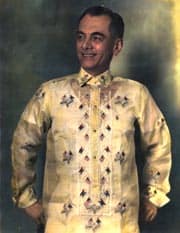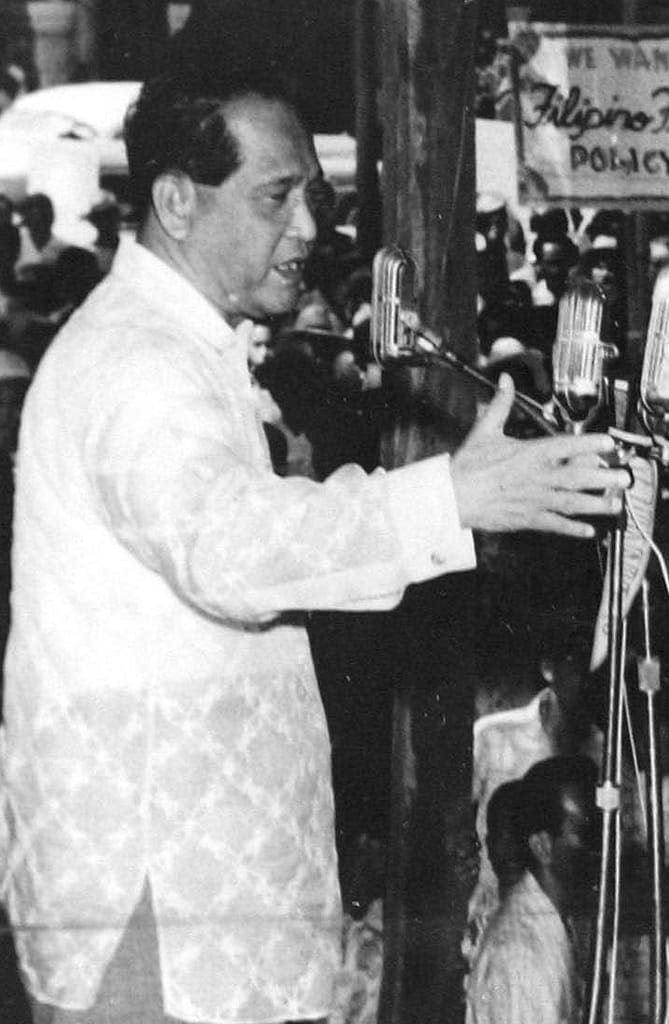
The Barong Tagalog: Philippine Presidents
In more recent times the barong fully established its reputation as the national garment. Part of the credit for the long overdue tribute goes to some Philippine presidents.

Commonwealth President Manuel Luis Quezon (1935-44), who made Tagalog the basis for the national language, also declared the barong the Philippine national dress. After the inauguration of the transition government, the “Commonwealth barong Tagalog” surfaced with Quezon himself modeling the outfit in a photograph published in various newspapers. Its embroidery depicted the crossed flags of the Philippines and the United States and scrolls inscribed with “Tydings-McDuffie.” The latter toasted the most important provisions of the Tydings-McDuffie law enacted by the U.S. Congress: the installation of the Commonwealth and the granting of full Philippine independence after a ten-year transition period.
The first two presidents of the Third Republic, Manuel A. Roxas (1946-48) and Elpidio R. Quirino (1948-53), trotted out their white sharkskin suits and black tuxedos at formal events, but they also gave the barong appreciable visibility. Two noticeable changes in style—it was shorter and was embroidered with colorful Philippine scenes—resonated the spirit of the times. Filipinos were recovering from a devastating war and had no choice but to live abstemiously, but they also were in a good mood and were eager to project their renewed faith in themselves and the nation.
Ramon Magsaysay (1953-57) proved himself worthy to be called the “President of the People.” At his swearing in, while all the men wore Western tailcoats, he put on a barong to dignify the Filipino image. At the reception afterward the traditional caviar and champagne were replaced by native food along with basi, the Ilocano wine. The grand ball was canceled and instead everybody partied at Plaza Santa Cruz and Rizal Memorial Stadium, the venues of the masses. For the remainder of his term, Magsasay would continue to strip the government of Western trappings. He wore the barong in official and personal gatherings. Filipinos followed his example and the barong became fashionable as business and formal wear.



Although Diosdado Macapagal (1961-65) took his oath of office in a tuxedo, he was a nationalist at heart. He is remembered for changing the Philippine independence celebration from July 4, a date chosen by the Americans to commemorate their own independence day, to June 12, the day in 1898 when Filipinos first declared their freedom from foreign rule. Macapagal was also partial to the barong, though he usually wore it only on formal occasions, which is probably why he liked it richer. Because of bolder and larger embroidery all over, the Macapagal barong became the favorite at weddings.
Ferdinand Marcos (1965-86) officially made the barong the national costume in 1975. He himself wore the garment on most occasions, but especially when receiving dignitaries at home or representing the country abroad on state visits and other international events. Marcos also popularized the working barong—an elegant version of the shortsleeved shirt-jack marked with the presidential seal.


Fidel V. Ramos (1992-98) had his own version of the working barong. Along with his trademark unlit cigar, he was often photographed with his barong rolled up, ready to tackle another busy day.
Joseph Ejercito Estrada (1998-2001) was inaugurated in historic rites held at Barasoain Church in Malolos, Bulacan, the seat of the First Republic. No other Philippine event has gathered under one roof a crowd dressed in the most resplendent barong. Living up to the singular honor as Centennial President, Estrada wore the garment on most official functions.
Corazon Cojuangco Aquino (1986-92) and Gloria Macapagal-Arroyo (2001-present) were inaugurated in street clothes: Aquino in her signature yellow dress at simple rites at Club Filipino; Arroyo in a drab gray suit on a makeshift stage at the EDSA Shrine. Of course both women never wore the barong per se, although they were—are—often outfitted in the garment’s feminine version. In fact, Aquino has lent it her personal touch. The “Cory barong” remains a popular style to this day.
Related Stories
Threads of Time: Unraveling the Rich History of the Barong Tagalog
In the tapestry of Filipino culture, the Barong Tagalog stands as a distinctive thread, weaving…Beyond Borders: Barong Tagalog as an International Symbol
In the global tapestry of fashion diplomacy, the Barong Tagalog emerges as a cultural ambassador,…Weaving Tomorrow: The Timeless Charm of the Barong Tagalog
Step into the world of the Barong Tagalog, where tradition dances with the future, creating…The Barong Tagalog: Early Beginnings
The barong tagalog is the upper garment worn on formal occasions by Filipino men (though…
